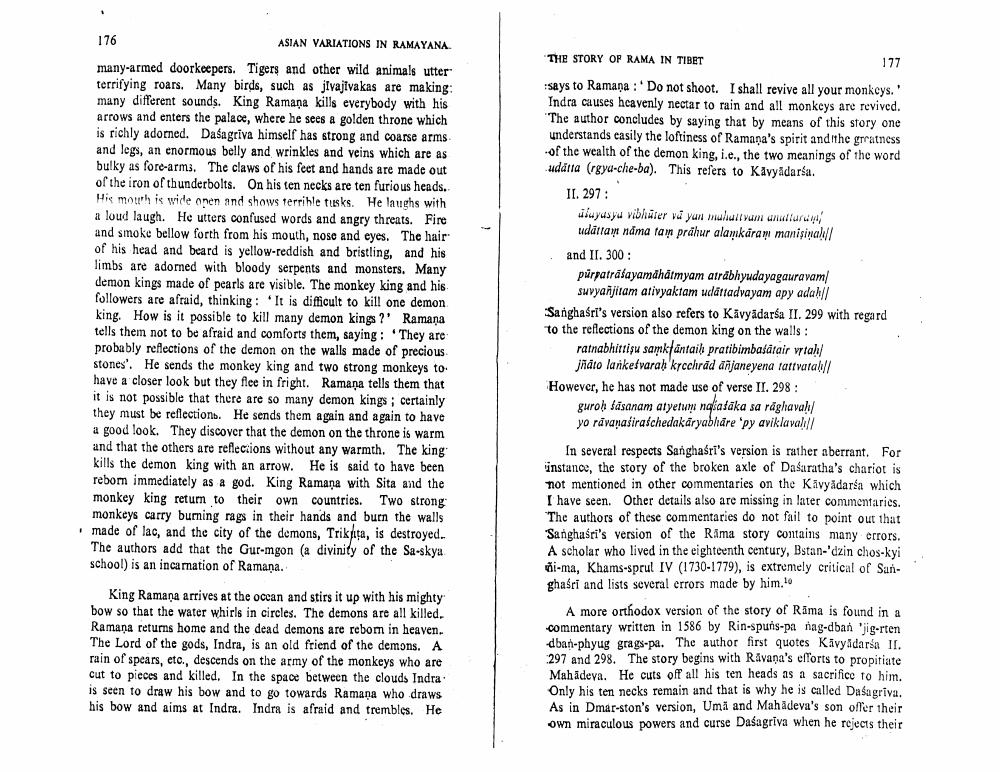Book Title: Story Of Rama In Tibet Author(s): J W De Jong Publisher: J W De Jong View full book textPage 8
________________ 1 ASIAN VARIATIONS IN RAMAYANA many-armed doorkeepers. Tigers and other wild animals utter terrifying roars. Many birds, such as jIvajivakas are making: many different sounds. King Ramana kills everybody with his arrows and enters the palace, where he sees a golden throne which is richly adorned. Dasagrīva himself has strong and coarse arms and legs, an enormous belly and wrinkles and veins which are as bulky as fore-arms. The claws of his feet and hands are made out of the iron of thunderbolts. On his ten necks are ten furious heads. His mouth is wide open and shows terrible tusks. He laughs with a loud laugh. He utters confused words and angry threats. Fire and smoke bellow forth from his mouth, nose and eyes. The hair of his head and beard is yellow-reddish and bristling, and his limbs are adorned with bloody serpents and monsters. Many demon kings made of pearls are visible. The monkey king and his followers are afraid, thinking: It is difficult to kill one demon. king. How is it possible to kill many demon kings? Ramana tells them not to be afraid and comforts them, saying: They are probably reflections of the demon on the walls made of precious. stones'. He sends the monkey king and two strong monkeys to have a closer look but they flee in fright. Ramana tells them that it is not possible that there are so many demon kings; certainly they must be reflections. He sends them again and again to have a good look. They discover that the demon on the throne is warm and that the others are reflections without any warmth. The king kills the demon king with an arrow. He is said to have been reborn immediately as a god. King Ramana with Sita and the monkey king return to their own countries. Two strong monkeys carry burning rags in their hands and burn the walls made of lac, and the city of the demons, Trikata, is destroyed.. The authors add that the Gur-mgon (a divinity of the Sa-skya school) is an incarnation of Ramana. 176 King Ramana arrives at the ocean and stirs it up with his mighty bow so that the water whirls in circles. The demons are all killed. Ramana returns home and the dead demons are reborn in heaven. The Lord of the gods, Indra, is an old friend of the demons. A rain of spears, etc., descends on the army of the monkeys who are cut to pieces and killed. In the space between the clouds Indra is seen to draw his bow and to go towards Ramana who draws his bow and aims at Indra. Indra is afraid and trembles. He THE STORY OF RAMA IN TIBET says to Ramana: Do not shoot. I shall revive all your monkeys.' Indra causes heavenly nectar to rain and all monkeys are revived. The author concludes by saying that by means of this story one understands easily the loftiness of Ramana's spirit and the greatness of the wealth of the demon king, i.e., the two meanings of the word udatta (rgya-che-ba). This refers to Kavyadarsa. II. 297: alayasya vibhater va yan muhattvam anuttura udattan nama tam prahur alamkaran manişinal and II. 300: 177 purpatralayamāhātmyam atrabhyudayagauravam suvyanjitam ativyaktam udattadvayam apy adaḥ Sanghasri's version also refers to Kävyädarśa II. 299 with regard to the reflections of the demon king on the walls: ratnabhittişu samkantaih pratibimbalatair vrtal jñāto lanketvaraḥ krechräd anjaneyena tattvataḥ However, he has not made use of verse II. 298: guroḥ fasanam atyetum nasaśāka sa rāghavaḥ yo ravanasiraśchedakaryabhare 'py aviklavali In several respects Sanghasri's version is rather aberrant. For instance, the story of the broken axle of Dasaratha's chariot is not mentioned in other commentaries on the Kävyädarśa which I have seen. Other details also are missing in later commentaries. The authors of these commentaries do not fail to point out that Sanghasri's version of the Rama story contains many errors. A scholar who lived in the eighteenth century, Bstan-'dzin chos-kyi ñi-ma, Khams-sprul IV (1730-1779), is extremely critical of Sanghasri and lists several errors made by him.10 A more orthodox version of the story of Rama is found in a -commentary written in 1586 by Rin-spuñs-pa nag-dbań 'jig-rten dban-phyug grags-pa. The author first quotes Kavyadarsa II. 297 and 298. The story begins with Ravana's efforts to propitiate Mahadeva. He cuts off all his ten heads as a sacrifice to him. Only his ten necks remain and that is why he is called Dasugrīva. As in Dmar-ston's version, Uma and Mahadeva's son offer their own miraculous powers and curse Daśagriva when he rejects theirPage Navigation
1 ... 6 7 8 9 10 11
